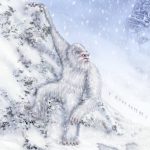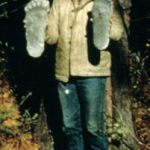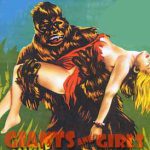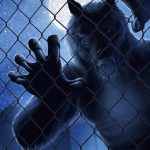The Yowie (also called Yahoo or the Great Hair Moehau in New Zealand) is an alleged hominid reputed to lurk in the Australian wilderness, similar to the Himalayan Yeti and the North American Bigfoot.
Description
The Yowie is very similar to Bigfoot with a height of six to seven feet tall and a thick black or brown fear covering the entire body. He is bipedal but has been seen running on all four legs at times.
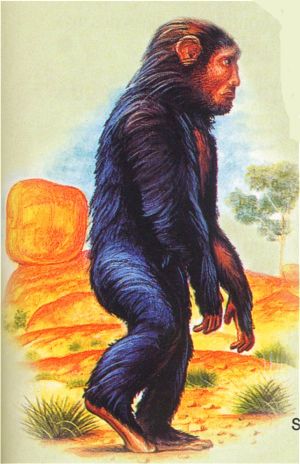
Habitat
The Yowie has been reported primarily in New South Wales, the Gold Coast of Queensland and in the wild bush country of the Moehau Range. In New Zealand, the North Auckland area and the West Coast are its favorite playground.
Sightings
The first recorded sighting of a Yahoo by a European came in 1881, when an Australian newspaper reported that several witnesses had seen a large baboon-like animal that stood taller than a man. In 1894, another individual claimed to come face to face with a “wild man or gorilla” in New South Wales bush. A 1903 newspaper printed the testimony of a man who said he watched as aborigines killed a Yahoo, which he said looked “like a black man, but covered all over with gray hair.”
In 1912, George Summerell was riding on horseback between Bombala and Bemboka when he saw a strange creature on all fours drinking from a creek. The animal rose up on its hind feet to a height of seven feet and looked at Summerell. Then it disregarded the horseman, finished its drink, and peacefully walked away into nearby woods. The following day, Summerell’s friend Sydney Wheeler Jephcott rushed to the scene of the sighting and discovered an abundance of handprints and footprints. Jephcott described the footprints as humanlike but huge, and having only four toes per foot. He said he made plaster casts of the tracks and turned them in to a local university, but there is no record of a scientific analysis being rendered.
In 1971, a Royal Australian Air Force helicopter carrying a crew of surveyors landed atop Sentinel Mountain, a remote and inaccessible peak. Much to their surprise, the team discovered fresh footprints in mud, much larger than human footprints, in a place where no known biped could possibly be present. Yowie sightings continued steadily throughout the ’70s. In 1976, backpackers in New South Wales reported seeing a five-foot female Yowie whose fur stank to high heaven. Also in New South Wales, Betty Gee reported seeing a giant creature covered with black fur outside her home in 1977. Shortly thereafter, her fence was knocked down and large footprints surrounded the scene. A man in the Gold Coast city of Springbrook said that a”big black hairy man-thing” appeared before him while he while chopping wood in 1978. “It just stared at me and I stared back,” he said. “I was so numb, I couldn’t even raise the axe I had in my hand.”
In 1997, a woman residing in Tanimi Desert was awakened at 3 a.m. by a horrible animal-like noise just outside her bedroom window. When she went out to investigate, she was confronted with an unbearable stench that sent her into the dry heaves, and she saw a seven-foot hairy creature tear through her fence as it made a hasty retreat. The next day, police discovered a number of giant ootprints and a somewhat shredded irrigation pipe that had seemingly been chewed upon.
Origins
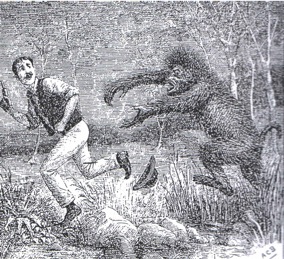
Jonathan Swift’s Gulliver’s Travels (1726) includes a subhuman race called the Yahoos. Hearing the aborigines’ fearful accounts of this malevolent beast, nineteenth-century European settlers probably applied the name Yahoo to the Australian creature themselves. Sometime in the 1970s, the term “Yowie” supplanted “Yahoo,” for reasons that remain as mysterious as the creature. One possible origin of the newer name is the aborigine word youree, described as a legitimate native term for the hairy man-monster. The Australian accent could easily contort “youree” into “Yowie.”
The earliest published reference to the word in its current usage is in Donald Friend’s Hillendiana, a collection of writing about the goldfields near Hill End in New South Wales. Friend refers to the “Yowie” as a species of “bunyip”, an Aboriginal term used to describe monsters said to dwell in many Australian rivers and lakes. Paranormal enthusiast Rex Gilroy popularized the word in newspaper articles during the 1970s and 1980s
Folklore
An aborigine folk tale explains that when their people first migrated to Australia thousands of years ago, they encountered on the new continent a savage race of ape-men. The aborigines’ ancestors went to war against the ape-men, and in the end the humans triumphed, thanks to their ability to make weapons. Some have wondered if this tale might contain some element of truth, and it is a few diehard survivors from this unknown primate species that would later be known as the Yahoo and the Yowie.
Theories
Australian Rex Gilroy, a self-proclaimed archeo-cryptozoologist, has attempted to popularize the scientific term Gigantopithecus australis for the yowie in his book Uru – The Lost Civilisation of Australia. He claims to have collected over 3000 reports of them and proposed that they comprise a relict population of extinct ape or Homo species. There is, however, no evidence that Gigantopithecus ever existed in Australia.


